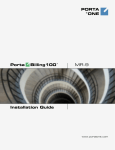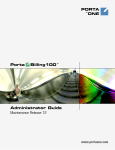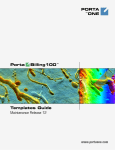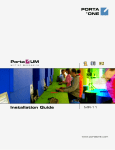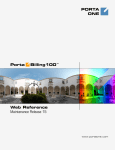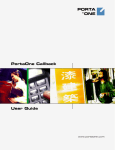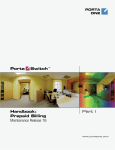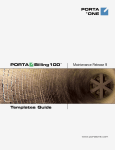Download PortaBilling: User Manual
Transcript
PORTA ® ONE PORTA Billing100 ® Installation Guide www.portaone.com PortaBilling Installation Guide Copyright notice & disclaimers Copyright (c) 2000-2006 PortaOne, Inc. All rights reserved. PortaBilling100 Installation Guide V.1.7.2 November 2003 Please address your comments and suggestions to Sales Department, PortaOne, Inc., Suite 400, 2963 Glen Drive, Coquitlam, BC, V3B 2P7, Canada Changes may be made periodically to the information in this publication. Such changes will be incorporated in new editions of the guide. The software described in this document is furnished under a license agreement, and may be used or copied only in accordance with the terms thereof. It is against the law to copy the software on any other medium, except as specifically provided in the license agreement. The licensee may make one copy of the software for backup purposes. No part of this publication may be reproduced, stored in a retrieval system, or transmitted in any form or by any means, electronic, mechanical, photocopied, recorded or otherwise, without the prior written permission of PortaOne, Inc. The software license and limited warranty for the accompanying product are set forth in the information packet supplied with the product, and are incorporated herein by this reference. If you cannot locate the software license, contact your PortaOne Representative for a copy. All product names mentioned in this manual are for identification purposes only, and are either trademarks or registered trademarks of their respective owners. (c) 2001-2006 PortaOne, Inc. All rights Reserved. www.portaone.com 1 PortaBilling Installation Guide Table of contents 1. Introduction ...................................................................................4 Hardware and Software Requirements ............................................................... 5 2. Installation Process .....................................................................7 Pre-install ....................................................................................................................... 8 Step 1: Power-Up, Boot Order Setup................................................................... 8 Step 2: Insert the CD-ROM...................................................................................... 8 Step 3: Start of Installation ..................................................................................... 9 Step 4: Welcome Screen ........................................................................................ 10 Step 5: Disk Partitioning, Overview.................................................................... 10 Step 6: Disk Partitioning, Choose Disk .............................................................. 11 Step 7: Disk Partitioning, Create Partition ....................................................... 11 Step 8: Disk Partitioning, Boot Manager........................................................... 13 Step 9: Disk Partitioning, Slice Layout............................................................... 14 Step 10: Choose the Installation Type .............................................................. 15 Step 11: Start of Installation................................................................................. 15 Step 12: Network Configuration, Choose the Network Interface............ 16 Step 13: Network Configuration, Parameters ................................................. 17 Step 14: Add User Accounts into the System ................................................. 18 Step 15: Time Zone Configuration...................................................................... 19 Step 16: Setting-up Root Password.................................................................... 22 Step 17: Preparing to Reboot ............................................................................... 23 Step 18: Check that the System Reboots to a Normal State .................... 24 Step 19: Preparing the System for Transportation (Optional) ................. 24 (c) 2001-2006 PortaOne, Inc. All rights Reserved. www.portaone.com 2 PortaBilling Installation Guide Preface This document provides a general overview of the PortaBilling100 Customer Care Staff web interface. Where to Get the Latest Version of this Guide The hard copy of this guide is updated at major releases only, and does not always contain the latest material on enhancements occurring inbetween minor releases. The online copy of this guide is always up-todate, integrating the latest changes to the product. You can access the latest copy of this guide at: www.portaone.com/solutions/billing/docs. Conventions This publication uses the following conventions: Commands and keywords are in boldface Terminal sessions, console screens, or system file names are displayed in fixed width font Caution means ‘reader beware’. You are capable of doing something that might result in program malfunction or loss of data. NOTE: Means reader take note. Notes contain helpful suggestions or references to materials not contained in this manual. Timesaver means the described action saves time. You can save time by performing the action described in the paragraph. Tips Means the following information might help you solve a problem. (c) 2001-2006 PortaOne, Inc. All rights Reserved. www.portaone.com 3 Introduction 1. Introduction (c) 2001-2006 PortaOne, Inc. All rights Reserved. www.portaone.com 4 Introduction PortaBilling runs on most modern UNIX operating systems (FreeBSD, Linux, Sun Solaris, etc.), assuming they are equipped with such basic features as an ANSI C compiler. However, it might be difficult for an inexperienced system administrator to install and configure the operation system in a way that suits all the requirements and provides the best performance. Installing all the pre-requisite software (libraries, Perl modules, MySQL server) might also be a time-consuming task. The PortaBilling JumpStart installation CD provides a quick and foolproof way to perform the complete server installation from scratch in less than 15 minutes! It contains installation media for FreeBSD 4.9, with all the necessary packages, as well as PortaBilling itself. The installation wizard uses a text-mode GUI. Use arrow keys to change your selection, “Tab” to move between the fields and “Enter” to make a choice. Hardware and Software Requirements Recommended configuration: • • • Pentium 4 CPU 2.8 GHz Motherboard with 533MHz/800MHz system bus support 1 GB of RAM Make sure that your servers are installed and equipped with all the required hardware, namely: • • • • • Network card CD-ROM (in the case of the IDE CD-ROM, we recommend that you connect it as a slave on the secondary IDE channel) Video adapter/monitor/keyboard (required only during the installation process) At least one disk drive USB slot (on the master server) Please check that other hardware installed on your server (such as network adapter, RAID controller, etc) is supported by the FreeBSD. You can check this at the FreeBSD website http://www.freebsd.org. During installation you will be prompted for your network configuration parameters. Please decide on this matter before beginning installation, consulting your network administrator if necessary. While it is possible (c) 2001-2006 PortaOne, Inc. All rights Reserved. www.portaone.com 5 Introduction that you will have to perform installation before the network is available (in your office, for example, while the servers will be located in a server hosting center), you will still need to enter the correct data. Please have the following ready: • • • Planned hostnames and IP addresses of the master and slave servers Subnet mask and address of the default gateway Address of your DNS server If a hardware RAID controller is available in your system, configure the RAID array. Recommended configurations (depending on the number of hard drives in the system) are as follows: • • • • 2 disks – RAID (mirroring) 3 disks – RAID 1 (mirroring) on the first two disks, with the third one left as a hot spare 4 disks – RAID 1+0 (mirroring + striping) More than 4 disks – RAID 1+0 (mirroring + striping) on the first four disks, with the others left as a hot spare (c) 2001-2006 PortaOne, Inc. All rights Reserved. www.portaone.com 6 Installation Process 2. Installation Process (c) 2001-2006 PortaOne, Inc. All rights Reserved. www.portaone.com 7 Installation Process Pre-install Place the USB dongle key you received with your PortaBilling installation CD into the USB slot on your master server. Step 1: Power-Up, Boot Order Setup Power-up the computer which you plan to use as a server. Enter the BIOS setup, making sure that the CD-ROM is first in the list of boot devices. If you are installing a dual-server configuration, start your installation with the master server. Note: this image is only an example. The BIOS on your system might look different. Save your changes and exit. Step 2: Insert the CD-ROM While rebooting the system, insert the PortaBilling installation CD in the CD-ROM drive. If you do not insert it quickly enough and get a “no operation system” error (or a previously installed operating system starts (c) 2001-2006 PortaOne, Inc. All rights Reserved. www.portaone.com 8 Installation Process its boot-up process), press the “Reset” button and make sure that you are booting from the CD. Step 3: Start of Installation You will know that JumpStart installation has started if you see a screen similar to the one below: After the installation kernel is loaded, you will see the following menu: Choose the first item in the menu and press “Enter” to go on. (c) 2001-2006 PortaOne, Inc. All rights Reserved. www.portaone.com 9 Installation Process Step 4: Welcome Screen Next, the installation process starts. First you will see the PortaBilling welcome screen: Press “Enter” to continue to disk partitioning. Step 5: Disk Partitioning, Overview Now you must allocate the hard drive partitions where FreeBSD and PortaBilling will be installed. If you only have one hard drive in your system, or your available disks are configured as a single volume array, then skip the next step and go directly to 0. (c) 2001-2006 PortaOne, Inc. All rights Reserved. www.portaone.com 10 Installation Process Step 6: Disk Partitioning, Choose Disk If you have more than one disk in your system, you will have to choose which one you would like to create the FreeBSD partitions on. If in doubt, choose the first disk on the list. Step 7: Disk Partitioning, Create Partition Now you need to create the partition, that is, the continuous area on the disk used to store all the operating system data. With the “unused” entry highlighted, press “C” to create a new partition. (c) 2001-2006 PortaOne, Inc. All rights Reserved. www.portaone.com 11 Installation Process When prompted for the partition size, simply press “Enter”; this will allocate all the available space on the disk for FreeBSD. Press “Q” to exit this configuration screen. When asked about the partition type, press “Enter”, so that the partition is created with the default FreeBSD type. After the partition has been created, make sure it is marked as a bootable partition. To do this, select the new partition using the cursor movement keys, and then press “S”. Press “Q” to exit this configuration screen. (c) 2001-2006 PortaOne, Inc. All rights Reserved. www.portaone.com 12 Installation Process Step 8: Disk Partitioning, Boot Manager The FreeBSD boot manager will let you boot one of the multiple operating systems installed on your server. Choose “Standard” if you are not planning to run anything other than FreeBSD and PortaBilling on your server. (c) 2001-2006 PortaOne, Inc. All rights Reserved. www.portaone.com 13 Installation Process Step 9: Disk Partitioning, Slice Layout You must create areas for holding different file systems within the FreeBSD partition. These areas are called slices. Press “A” to use the install wizard default layout. If you want a custom slice layout, the recommended PortaBilling slice set-up is: • / (root) filesystem – 256MB • swap – equal to the amount of RAM • /usr filesystem – 2GB • /var filesystem – the rest of the available space When finished, you should see something similar to the following screen: (c) 2001-2006 PortaOne, Inc. All rights Reserved. www.portaone.com 14 Installation Process Press “Q” to proceed with the installation. Step 10: Choose the Installation Type Next you need to choose the installation type. This will determine which packages will be installed on this host. If you are installing a dual-server configuration, it is recommended that you install the master server first. Step 11: Start of Installation Your confirmation is required before the disk layout is changed and the partitions reformatted. Press “Enter” to proceed. During installation you will see screens similar to the following: (c) 2001-2006 PortaOne, Inc. All rights Reserved. www.portaone.com 15 Installation Process Step 12: Network Configuration, Choose the Network Interface Choose the primary network interface for your server, that is, the interface through which the server will communicate with the rest of the Internet, including your VoIP gateways or RADIUS servers. Your Ethernet network adapter should be on top of the list. If not, this could mean the adapter you have in your server is not supported by FreeBSD. (c) 2001-2006 PortaOne, Inc. All rights Reserved. www.portaone.com 16 Installation Process Step 13: Network Configuration, Parameters Now you need to enter the network parameters for your server. Press “Enter” when done. Master server installation For the master server, the following dialog will appear: Slave server installation Here the dialogs are the same, but you need to enter the IP address of the master server: (c) 2001-2006 PortaOne, Inc. All rights Reserved. www.portaone.com 17 Installation Process Single-host installation The dialog for a single-host installation is similar to the ones above, except that you do not need to enter information for master/slave server addresses. Step 14: Add User Accounts into the System After the required packages have been installed, you can begin performing the configuration tasks. First you will be required to add user accounts to the system. Your staff may use these accounts to log in to the system. (It is not recommended to use the root account when logging in remotely.) If you plan to add users, choose the first menu item and press “Enter”. Once you have finished the user creation process, press “Tab” once (to move to the “Cancel” button) and then press “Enter”. The dialog for creating a new user is shown below: (c) 2001-2006 PortaOne, Inc. All rights Reserved. www.portaone.com 18 Installation Process Step 15: Time Zone Configuration Having your clock adjusted properly and setting up a time zone correctly are essential for accurate billing. Normally, people choose the time zone where their server is physically located, or which is local to the majority of the system administrators. First of all, choose whether you want your server clock to be set according to UTC or local time. We recommend using local time, in which case you should choose “No” here. Next, choose which region you are in: (c) 2001-2006 PortaOne, Inc. All rights Reserved. www.portaone.com 19 Installation Process And then choose your country: If there is more than one time zone in the given country, you will have to specify the correct one: (c) 2001-2006 PortaOne, Inc. All rights Reserved. www.portaone.com 20 Installation Process Please check the suggested time zone, and confirm: NOTE: Always choose the same time zone when installing the master and slave servers. (c) 2001-2006 PortaOne, Inc. All rights Reserved. www.portaone.com 21 Installation Process Step 16: Setting-up Root Password Choosing a super user password is very important, as you will need it to perform system administration or system recovery. Choose a password that is difficult to guess or crack. (c) 2001-2006 PortaOne, Inc. All rights Reserved. www.portaone.com 22 Installation Process Step 17: Preparing to Reboot Installation is now finished. Press “Enter” when you reach the following screen. Once the system begins its reboot process, remove the installation CD from the CD-ROM. Do not forget to enter BIOS again and change the priority of boot devices so that the hard drive will now be the first boot device attempted. (This ensures faster reboot when recycling the server.) (c) 2001-2006 PortaOne, Inc. All rights Reserved. www.portaone.com 23 Installation Process Step 18: Check that the System Reboots to a Normal State It is good idea to make sure that the system is in a stable state, and that it returns to normal operations on reboot without the need for any intervention, especially if no keyboard or other peripherals are to be attached. The screen should look like this after a normal reboot: Press Ctrl + Alt +Del if you need to reboot. Step 19: Preparing the System for Transportation (Optional) If you need to transport the system to another location (e.g. hosting center) or otherwise power down the system safely, proceed as follows: • Wait until the system finishes booting • Log in as root • Type shutdown –p now • Wait until either the system powers down on its own or a message reading “The operating system has halted” appears, and then power off the server. (c) 2001-2006 PortaOne, Inc. All rights Reserved. www.portaone.com 24

























